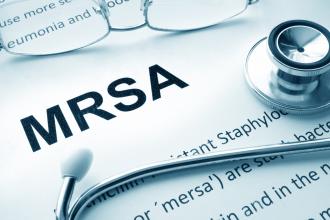Management of community-associated methicillin-resistant Staphylococcus aureus infections in primary care
New strains of methicillin-resistant Staphylococcus aureus (MRSA) have emerged in the community and sometimes cause aggressive infections in otherwise healthy people.[1-9] Along with severe skin and soft tissue infections, these include rare but devastating illnesses, such as necrotizing pneumonia. A recent meeting in BC confirmed that there has been broad emergence of MRSA in communities across the province over the last 12 to 24 months.[10]
Interim guidelines have been developed collaboratively by the British Columbia Centre for Disease Control, the BC Association of Medical Microbiologists, BC infectious disease practitioners, and the BC Provincial Infection Control Network. These were prompted by concerns from physicians that no guidance was available on management of this problem as it emerged. The guidelines are now posted in full at www.bccdc.org/content.php?item=194.
Diagnosis
• MRSA, including community-associated MRSA (CA-MRSA), should be considered in the differential diagnosis of any classical staphylococcal presentation.
• Complicated abscesses should be incised and the secretions sent for bacterial culture and sensitivity testing. (Note that most uncomplicated abscesses will resolve without antibiotic therapy and culture of MRSA from an uncomplicated abscess is not an indication for antibiotics).
• All patients with systemic illness should have blood cultures taken.
• Current groups who have a higher risk of CA-MRSA include:
- Persons with histories of intravenous drug use, homelessness, or incarceration.
- Some First Nations populations.
- Those with close contact with individuals within these risk groups or with populations where CA-MRSA is endemic (some areas of the United States and some Third World countries).
• Patterns of resistance can change and optimal therapy should be guided by knowledge of susceptibility pattern of the patient’s isolate.
Management
The management of MRSA infection and colonization was recently reviewed in an Association for Medical Microbiology and Infectious Disease (AMMI Canada) position paper[11] and the BC interim guidelines are summarized in the Figure.
• First, localized, uncomplicated abscesses generally will not require antibiotic treatment. Drainage and local management are normally sufficient to attain resolution.
• If indicated, antimicrobial treatment of CA-MRSA infections must be guided by knowledge of the laboratory susceptibility pattern. This is because susceptibility patterns vary among CA-MRSA but also because some infections diagnosed at the community level involve hospital-associated strains, which have a narrower spectrum of susceptibility.
• Referral for specialist care should be considered in cases refractory to therapy, cases of invasive infection (e.g., bloodstream, pneumonia), and other presentations where parenteral therapy is considered.
Prevention and control
• Be sure to wash hands or use an alcohol-based hand antiseptic before and after contact with colonized or infected patients: the key to preventing transmission. Antibiotic-resistant organisms are usually spread on the hands of health care providers.
• Wear a barrier (e.g., gloves) when it is anticipated that the health care provider will come in contact with mucous membranes, open areas, or body fluids.
• Ensure that patient care items and contaminated environmental surfaces are cleaned and disinfected between patients, including medical equipment (e.g., exam tables, chairs, stethoscopes) used in the care of the patient. In an ambulatory care centre, use of a hospital-grade disinfectant is acceptable.
—David M. Patrick, MD, FRCPC
Director, Epidemiology Services, BCCDC
—Bonnie Henry, MD, FRCPC
Physician Epidemiologist, BCCDC
—Bruce Gamage, BSN, RN
Infection Control Consultant, Laboratory Services, BCCDC
References
1. Four pediatric deaths from community-acquired methicillin-resistant Staphylococcus aureus—Minnesota and North Dakota, 1997–1999. MMWR Morb Mortal Wkly Rep 1999;48:707-710. Full Text
2. Methicillin-resistant Staphylococcus aureus skin or soft tissue infections in a state prison—Mississippi, 2000. MMWR Morb Mortal Wkly Rep 2001;50:919-922. Full Text
3. Outbreaks of community-associated methicillin-resistant Staphylococcus aureus skin infections—Los Angeles County, California, 2002–2003. MMWR Morb Mortal Wkly Rep 2003;52:88. Full Text
4. Methicillin-resistant Staphylococcus aureus infections among competitive sports participants—Colorado, Indiana, Pennsylvania, and Los Angeles County, 2000–2003. MMWR Morb Mortal Wkly Rep 2003;52:793-795. Full Text
5. Methicillin-resistant Staphylococcus aureus infections in correctional facilities—Georgia, California, and Texas, 2001–2003. MMWR Morb Mortal Wkly Rep 2003;52:992-996. Full Text
6. Francis JS, Doherty MC, Lopatin U, et al. Severe community-onset pneumonia in healthy adults caused by methicillin-resistant Staphylococcus aureus carrying the Panton-Valentine leukocidin genes. Clin Infect Dis 2005;40:100-107. PubMed Abstract Full Text
7. Herold BC, Immergluck LC, Maranan MC, et al. Community-acquired methicillin-resistant Staphylococcus aureus in children with no identified predisposing risk. JAMA 1998;279:593-598. PubMed Abstract Full Text
8. Yamasaki O, Kaneko J, Morizane S, et al. The association between Staphylococcus aureus strains carrying panton-valentine leukocidin genes and the development of deep-seated follicular infection. Clin Infect Dis 2005;40:381-385. PubMed Abstract Full Text
9. Mulvey MR, MacDougall L, Cholin B, et al. Community-associated methicillin-resistant Staphylococcus aureus, Canada. Emerg Infect Dis 2005;11:844-850. PubMed Abstract Full Text
10. BC Centre for Disease Control. A Report on the Emergence of Community-Acquired Methicillin-Resistant Staphylococcus aureus (CA-MRSA) in British Columbia www.bccdc.org/news.php?item=143 (accessed 24 February 2006).
11. Simor A, Loeb M, and the CIDS/CAMM Guidelines Committee. The management of infection and colonization due to MRSA: A CICDS/CAMM position paper. www.ammi.ca/pdf/MRSApositionpaper.pdf (accessed 24 February 2006).

